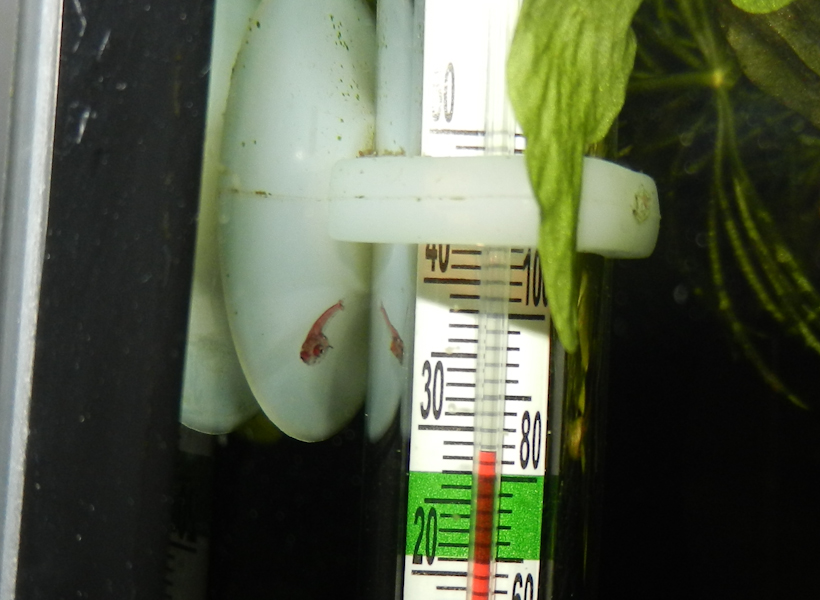- This topic has 27 replies, 8 voices, and was last updated 12 years, 11 months ago by
Nicolas BUISSON.
-
AuthorPosts
-
May 11, 2012 at 11:58 pm #4362
Peter Finke
ParticipantYes, P. nagyi is no quite as easy as filamentosus or linkei, but not more difficult than the bintan-variants.
But mind: The real experts don’t rely on the “natural method” and look for young that survive in their parent’s home. Instead they take a small special tank for spawning and caring the eggs and larvae by the father-fish, and then remove the larvae when they are short from leaving the cave. Mostly, you can produce many young only this way. It is rare that you have pairs that don’t touch their young at all. I once had a linkei pair and a filamentosus-pair that were very caring for them. In both cases I finally could “harvest” more than fifty resp. sixty young from a well-planted 12-liter-tank in which thay had grown aside their parents.May 16, 2012 at 4:16 pm #4366Steffens, Sylvia
ParticipantThank you all :cheer:
Peter: If I am more familar with breeding Parospromenus, i’ll try to do the “expert way”. At the moment I am happy that my fishes are well, healthy and generally in the mood to breed.
On the day before yesterday I saw the one male hiding deep in a half flower pot. Using an electric torch I could see lots of eggs at the end of the pot. Yesterday the eggs still have been there and the male was still watching them. And I found another young fish, a bit smaller and much younger.
May 20, 2012 at 12:01 am #4376helene schoubye
KeymasterHi Nathea, – congratulation with your juvenile nagyi … I find there no better feeling than when you spot these tiny fish in your tank, – but sometimes I am really astonished that I do not notice them before they are almost grown up 🙂 …
I have nagyi too, and find them so beautiful – one of my favorite species.
Glad to hear you have them too, and thriving well.May 28, 2012 at 7:49 pm #4389Steffens, Sylvia
ParticipantHello all again,
I would like you to take part in my last Parosphromenus pictures. I’ve got some nice shots of the youngest ones:




Meanwhile I found about 10 young (could be more) fishes from different spawnings and it is fascinating to watch them. They act like their parents, impressing each other and changing their colour from light stripes to darker stripes. They seem to grew up very fast.
May 28, 2012 at 11:46 pm #4390helene schoubye
KeymasterThank you for sharing your photoes, – they are really small, arent they ?Imagine how small they would have been even before..
May 29, 2012 at 4:27 am #4391Marcin Chyla
ParticipantHello, very nice pictures. Do You feed your fry some how? Or they only finding microorganisms which are in Your aqua? Those fry on last picture seems to eat artemia naulpi regarding to orange stomach 🙂 Greetings!
June 6, 2012 at 1:22 am #4399Steffens, Sylvia
ParticipantHello Martin,
the older fry only could have been found microorganisms that have been in the tank, because I didn’t feed any special food. But the tank is sort of crowdes, with a lot of leaves on the ground. Maybe an excellent place to hide and find the first food.
3 times a week the Fishes get Artemia nauplies. Sometimes I actually offer some portions of “rettichtierchen” (Spirostomum cf. ambiguum), microorganisms that look a bit like paramecia, but it is much easier to produce.
The parents mostly ignore the rettichtierchen, but the fry love it.
Meanwhile i can see about 10 – 12 young fishes at different ages in my tank, and they parenta are about to breed.
July 19, 2012 at 2:07 am #4445Steffens, Sylvia
ParticipantHello all,
fortunately I was able to take a nice snapshot of my breeding Parosphromenus nagyi. The larvae swim in a cave that we name “Überraschungsei”. It seems like it is welcome to the fish, it is the second time that he used it for breeding.
 July 19, 2012 at 10:46 am #4446
July 19, 2012 at 10:46 am #4446Bill Little
ParticipantSylvia — am I to understand you have two caves with fry in both caves at the same time? What are the caves made of? Are they the size of the film canisters that Peter has described in previous posts? Are they laying on the floor of the tank?
July 19, 2012 at 4:14 pm #4447Steffens, Sylvia
ParticipantNo, he is using this cave twice in a row.
Since I placed this one (it floats at the surface) he ignores the two other caves at the ground. Astonishingly he changes its colour to beige when he is sitting in the cave. If he leaves it (e.g. for food) the “normal” darker colours come back.
The cave is made of “plastic” and it normally contains chocolate. The size is nearly the same as a film canister, but I was’nt able to get such a film canister here, so I looked out for an alternative.
July 19, 2012 at 7:50 pm #4448Bill Little
ParticipantThat must be some GREAT chocolate!! 🙂
July 19, 2012 at 8:17 pm #4449Steffens, Sylvia
ParticipantHey, it is’nt as big as it sounds like 😉 and I did’nt describe it correctly: The container is not fullfilled with chocolate, but is covered with it and it has a size more or less like a real chicken-egg. The container inside is a bit smaller than the egg itself.
In case of you are interested, here is a link that can explain it better:
http://de.wikipedia.org/wiki/Kinder_%C3%9Cberraschung
http://en.wikipedia.org/wiki/Kinder_Surprise (english)July 19, 2012 at 11:52 pm #4451Nicolas BUISSON
ParticipantCongratulations !! very good work and very nice pictures !! 🙂
-
AuthorPosts
- You must be logged in to reply to this topic.

